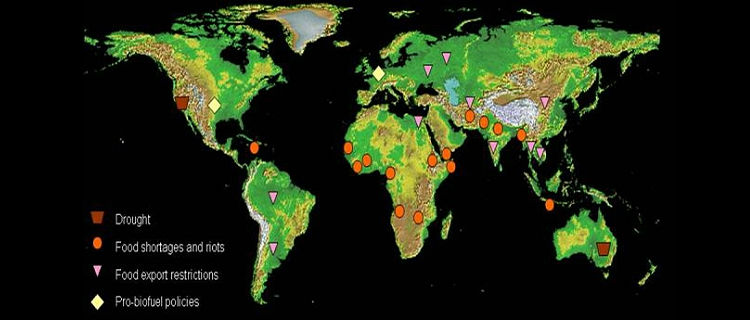A new landscape of global crises – everything is connected
Stockholm, Sweden – In the past crises were often local and isolated. They left surrounding ecosystems and societies largely unaffected. This made aid and governance work easier.
Today, crises are becoming more global in reach affecting more people and systems at the same time according to new research carried out at the Stockholm Resilience Centre.
In a recent study lead by Thomas Homer-Dixon and Brian Walker published in Ecology and Society a framework to identify the causes, processes and outcomes of multiple interconnected crises which they term “synchronous failure” is proposed.
A guide for understanding globally interconnected crises
The framework, developed with the assistance of Stockholm Resilience Centre researchers, shows how several stressors together can cause a crisis which can rapidly spread to become global in reach.
“We have developed a framework for understanding how global crises may emerge,” says Oonsie Biggs, a Stockholm Resilience Centre researcher
“Our framework could be used as an initial guide for systematic analyses and identifying early-warning signals and measures for building social-ecological resilience. It can also support establishment of appropriate governance structures that can navigate the danger of synchronous failure,” she says.

Causes of crises
The authors argue that future crises will increasingly result from three long-term global trends: the dramatic increase in human economic activity in relation to Earth’s environment, the rapidly increasing connections across the globe, and the decreasing diversity of human cultures, institutions, practices and technologies.
These three trends create several stresses and reduce the capacity of systems to deal with disturbances. Case studies from the 2008 financial-energy and food-energy crises illustrate this.
In the food-energy crises four stresses seemed to have affected the systems simultaneously, sometimes enhancing the impacts on one another:
1. diminishing supply of new agricultural land of good quality
2. declining returns on intensifying agriculture through more extensive inputs
3. climate change related extreme weather such as droughts
4. consistent high demand for food in a world with a growing population.
Three processes at play
The authors identify three processes that occur in such a crisis, often simultaneously and reinforcing each other.
The first is the long fuse big bang where slow burning stresses suddenly reach a tipping point. The straw that broke the camel’s back is not a steadily increased pressure with proportional response throughout but rather a sudden shift.
The second process, simultaneous stresses, emphasizes that many stresses can act on a system simultaneously, for example drought, poverty and social conflict. The relationships and the combined effect of them are important to understand in order to predict their effect and outcome.
The third type called ramifying cascade occurs when sudden and severe disturbances spread through tightly connected networks.
Outcomes
The synchronous failures that the authors outline stem from shifts in social-ecological systems that may be unexpected and irreversible. It occurs in several systems at once, developing quickly to reach a global scale.
Taken together, future risks may lead to shifts in social-ecological systems that will be difficult to reverse. This could have catastrophic consequences on development as vital ecosystems and ecosystem services are affected.
“The future wellbeing of humankind depends on functioning energy, food, water, climate and financial systems. It is increasingly clear how tightly these systems are connected,” concludes the report.
“We encourage further research on how energy, food, water, climate and financial systems are connected. This type of knowledge is important to understand our capacity to sustain these systems and learn how to deal with crises in the future.



